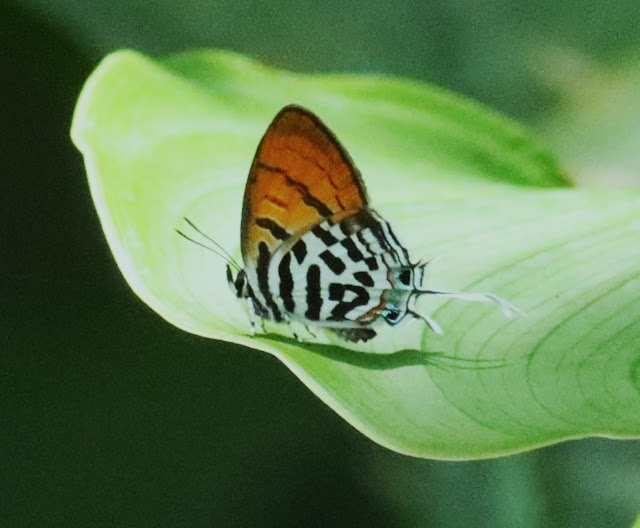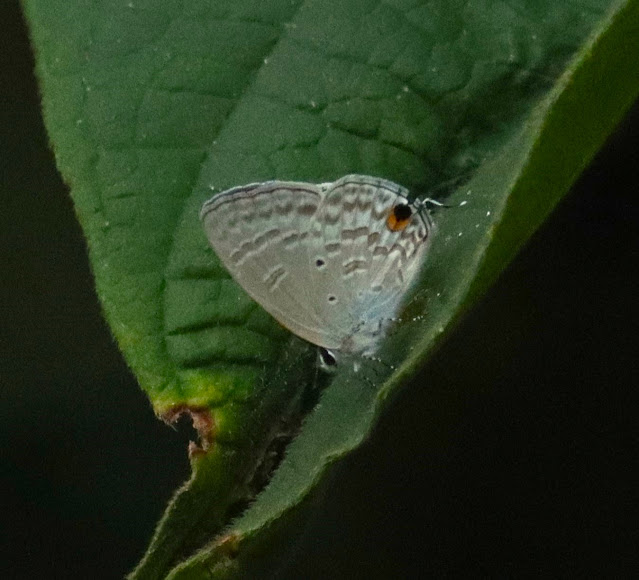Looks like the month of April 2024 is filled with Hasora and Burara species. These species mainly appear at dawn or dusk where there are less light. Hence you can see that their eyes are slightly larger than other day-time species like Arhopalas.
Violet Awl
(Hasora leucospila leucospila)
Lifer !!
Violet Awl
(Hasora leucospila leucospila)
They are quite a fast flyer.
Since they like to hang around at dimly lit places, you will need to use an external flashlight to get clearer photos of them.
Violet Awl
(Hasora leucospila leucospila)
Looks like the one I saw above is a male.
Orange Branded Awl
(Burara oedipodea oedipodea)
This Burara is uncommon and it's the first I am seeing it. It can be differentiated by other similar looking orange colored Awls by its bluish thorax.
Plain Banded Awl
(Hasora vita vita)
The above three Awls were all missing when others visited the same location subsequently. It shows that there is a possibility that they might just be frightened away if their habitat has been disturbed.
Except for this Awl.
Yellow Banded Awl
(Hasora schoenherr chuza)
This Awl was seen a few times and on a few different locations as well. It is the most common Awl you would come across over here. But photographing it can be a challenged unless it stops flying around.
Lets move to other interesting species.
Angled Cyclops
(Erites angularis)
You won't get to see Cyclops on the plains or forest edges. Usually they are found inside the forest.
Angled Cyclops
(Erites angularis angularis)
I have noticed that Cyclops like to fly close to the ground as well.
Although they can be skittish but they are not really some fast flyers.
Hanging nearby is another Cyclops and it's reported to be rare some more.
Cyclops Bushbrown
(Mycalesis mnasicles perna / Culapa mnasicles perna)
Initially I had just passed it off as a Faunis until another butterfly group expert corrected its ID. This has to be another lifer !!
(Scobura phidita)
Like its name suggest, most of the time I've only seen them inside the forest.
Bamboo Tree Brown
(Lethe europa malaya)
It was seen on the top of a bamboo like its name suggest. Have not seen this species for a long time.
Common Red Forester
(Lethe mekara gopaka)
This is not a common species as it name may suggests.
Another forest citizen.
Common Red Forester
(Lethe mekara gopaka)
Once it comes down to puddle you can get quite close to it.
Pygmy Posy / Lesser Posy
(Drupadia rufotaenia rufotaenia)
A pristine looking as well as an uncommon Posy.
White-tipped Palmer
(Lotongus calathus calathus)
When they are in season, they can be seen in a few places. So they might not be rare after all.
Here, it got spooked by the flash light which shows its hyline spots.
Royal Assyrian
(Terinos terpander robertsia)
A popular species among the photographers due to its colorful wings. I got a few hundred 'likes' for the above photo alone but unfortunately it didn't reach a thousand like some photos out there.
Silver Forget-me-not
(Catochrysops panormus exigus)
Its scientific name sounds just as interesting as its common name. However, you don't see this species so often like a Jamides or a Nacaduba.
At times you don't have to travel far to see your lifer. They can visit you instead like this Jamides.
Royal Cerulean
(Jamides caeruleus)
Not many people like to photograph an Allotinus - probably for the following two reasons - i) they can be difficult to identify and ii) their outlook are generally plain.
Small Malayan Darkwing
(Allotinus strigatus malayanus)
Rounded Darkwing
(Allotinus corbeti)
Common Faun
(Faunis canens arcecilas)
Here comes the 'giants' !
Koh-i-noor
(Amathusidia amythaon dilucida)
At first it was just at the side of the trail and I didn't notice it until it flew deeper into the bush. I had to climb a steep slope just to take this photo.
Palm King
There are a few Ssp of Palm Kings here and I think the above could be an Amathusia friderici holmanhunti.
This is probably the largest of them all.
Great Saturn / Giant Saturn
(Zeuxidia aurelius aurelius)
The above is a male and its field marks are all highlighted in the photo.
Here comes the species I liked most - Arhopalas
Large Metallic Oakblue
(Arhopala aedias agnis)
Large Metallic Oakblue
Showing its upperside
Large Metallic Oakblue
This is the same individual as above. Like most experienced butterfly spotters / entomologist would advise you, the tail alone is not necessarily a good indicator of an Arhopala. Here you can see that its tornal tails are 'missing'. So if you go for just the tail, you might just misidentify this oakblue.
I believe this is a Moore's Oakblue (Arhopala moorei busa).
I think ID is at 95% correct.
Here is another one.
Small Tailess Oakblue
(Arhopala antimuta)
ID is also probably 95% correct.
Elasticity
It doesn't bend it like Beckham but it almost managed it.
WHAT A MONTH AND CAN'T WAIT FOR MAY 2024 !!









































No comments:
Post a Comment